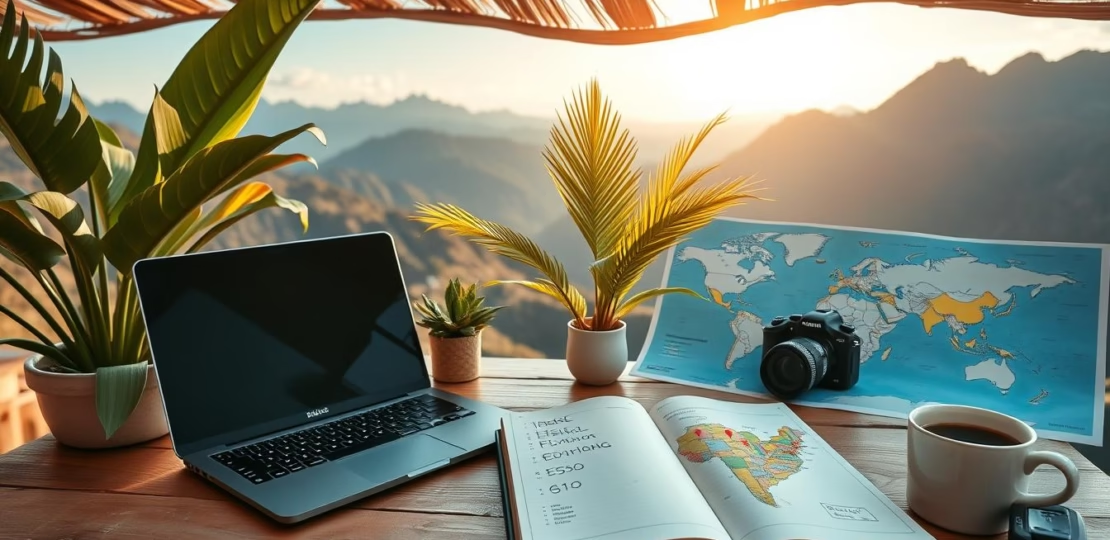Cost of Living for Digital Nomads: How to Budget Your Travels
December 30, 2024 | by m33559844@gmail.com

introduction: Cost of Living for Digital Nomads
Imagine waking up in a new country every day. Your office could be a beach, a café, or a mountain view co-working space. This is the life of many digital nomads who work remotely. But, managing money in a changing world can be tough.
It’s important to plan and budget well to travel and work sustainably. This way, you can enjoy your adventures without worrying about money.
The journey is both rewarding and unpredictable. Budgets can range from $1,000 in Southeast Asia to over $5,000 in Western Europe1. Knowing these costs is key for digital nomads to avoid unexpected expenses.
Learning to budget well lets you seize every chance with confidence. Every choice, from where you stay to local experiences, affects your money. Let’s explore the key parts of budgeting for a digital nomad’s life.
Key Takeaways
- The monthly budget for digital nomads varies significantly by location.
- Off-season travel can save up to 23% on costs.
- Hostels are usually the most cost-effective accommodation option.
- Effective use of credit cards can lead to substantial savings.
- Understanding monthly expenses helps in creating a sustainable travel budget.
If you’re ready to kickstart your travel journey with ease and exclusive savings, book your first trip now! Visit Trip.com using this special promotion link and register to reserve tickets, accommodation, and more. Don’t miss out on these incredible travel deals tailored for first-time travelers—start planning today!
Understanding the Digital Nomad Lifestyle
The digital nomad lifestyle is becoming very popular. It lets people work and travel at the same time. With better internet worldwide, remote jobs are easier to find, making it possible to work from anywhere2.
People love this lifestyle because it offers freedom. They can travel the world without giving up their jobs. It’s perfect for those who want to see new places and keep working.
Choosing the right place to live is key. Look for places with fast internet and good workspaces. Coworking spaces are great because they don’t require long-term leases2.
Many digital nomads prefer cities, like capital cities, for their better infrastructure. This makes it easy to work and enjoy local life at the same time.
Living costs vary a lot. In cities like Berlin, Prague, Paris, and Barcelona, you might spend $1000 to $2000 a month3. But, in places like Thailand and Bali, you can live well for about $500 a month3.
Living in developing countries can improve your life while you work. More travel apps and services, like Google Maps and Airbnb, make it easier to find places to stay and get around2.
Understanding the costs of the digital nomad lifestyle is important. As you meet locals and other nomads, you become part of the community. You find a balance between work and travel, making the most of your experiences2.
The Importance of Budgeting for Digital Nomads
For digital nomads, knowing how to budget is key to staying financially stable while traveling. Budgeting helps them plan for digital nomad expenses like where to stay, eat, and get around. Using apps like YNAB and Mint to track money can help manage finances better, avoiding surprises that could hurt their budget4.
Having a good budget lets them enjoy their travels more, without worrying about money. For remote workers, picking the right budget method is important. The 50/30/20 Budget rule is a good choice, where 50% goes to needs, 30% to wants, and 20% to savings or paying off debt5. This way, they can keep track of spending and save for the future.
Living in co-living spaces can also help with affordable housing and making friends with other nomads. Using platforms like Revolut, TransferWise, and N26 makes exchanging money easy and cheap4. Setting up automatic savings helps avoid overspending. By sticking to a budget, digital nomads can enjoy their travels more, knowing their finances are in order5.
Analyzing the Cost of Living for Digital Nomads
It’s key for digital nomads to understand their living costs. These costs can change a lot based on where they are and their lifestyle. Digital nomads face big expenses like where they live, what they eat, how they get around, and their bills.
Main Monthly Expenses for Digital Nomads
Housing is the biggest monthly expense for digital nomads. For example, in Sofia, Bulgaria, a single person spends about £1,150 ($1,794) a month. A family of four can spend around £2,301 ($3,571) a month there6. On the other hand, Cluj-Napoca, Romania, is cheaper, with monthly living costs of about €900 ($952)6.
Business expenses for digital nomads add up to £3,313 ($5,169) a year7. Overall, their yearly expenses can be about £22,200 ($34,637) after five years. But, their monthly costs are usually around £1,850 ($2,886)7.
Cost of Living for Digital Nomads : Comparing Living Costs by Region
Living costs vary a lot by region. Sofia, Bulgaria, has cheap housing, attracting many digital nomads6. Cities like New York, though, are much more expensive. Cluj-Napoca, Romania, is great for its fast internet and low costs, with an average monthly household expense of EUR 2,700 for families6.
Madeira Island in Portugal is also a good choice, with monthly costs of about EUR 1,200. It’s perfect for those who want a community and shared workspaces6. These differences show how digital nomads can plan their finances and choose the best places to live.
| Region | Average Monthly Expenses | Average Rent |
|---|---|---|
| Sofia, Bulgaria | €1,276 | €406 |
| Cluj-Napoca, Romania | €900 | *Not specified* |
| Madeira Island, Portugal | €1,200 | *Not specified* |
With these insights, digital nomads can better plan their finances. This helps them enjoy their global adventures more78.
Current Expenses of Digital Nomads
It’s key to understand the costs of living for digital nomads. They spend a lot on places to stay and food. Knowing these areas helps in planning a budget.
Cost of Living for Digital Nomads : Accommodation Costs in Popular Destinations
Accommodation is a big expense for digital nomads. A couple can spend up to £16,000 a year, about £25 a day9. They choose from hostels, Airbnbs, and long-term rentals, with prices changing by location.
In places like Southeast Asia, costs are lower than in Western Europe. This means a bigger budget for Western Europe. Staying in one place for longer can help save money on housing.
Food and Drink Expenses: Local Cuisine
Food costs vary based on what digital nomads eat and where they eat it. They spend about £4,100 a year on dining out9. Eating local can save money, like in Southeast Asia where meals are just $1.
In Europe, eating out can cost more. For groceries, they spend about £3,000 a year, or £250 a month for couples9. This way of eating not only saves money but also lets them enjoy local culture. It makes their travels more enjoyable and enriching.

If you’re ready to kickstart your travel journey with ease and exclusive savings, book your first trip now! Visit Trip.com using this special promotion link and register to reserve tickets, accommodation, and more. Don’t miss out on these incredible travel deals tailored for first-time travelers—start planning today!
Tools for Budgeting as a Digital Nomad
Managing money as a digital nomad needs the right tools. A digital nomad cost calculator helps estimate living costs. This lets travelers plan their budget before they go. Budgeting apps for digital nomads track spending and keep finances in check. These tools make budgeting easier and help prepare for expenses abroad.
Cost of Living for Digital Nomads : Using a Digital Nomad Cost Calculator
A digital nomad cost calculator makes budgeting easier by estimating living costs. Wise offers low fees for money transfers, which is great for travelers10. XE Currency provides live exchange rates and a currency calculator, helping manage different currencies10. These tools help nomads adjust their budgets as costs change.
Effective Budgeting Apps and Resources
Many budgeting apps are designed for digital nomads. YNAB offers a 34-day free trial and affordable subscription options11. PocketGuard helps track spending and reminds users about bills10. Mint is free and helps manage bank accounts11. QuickBooks and FreshBooks are great for freelancers, tracking income and expenses11.
| App/Tool | Cost | Main Features |
|---|---|---|
| YNAB | $14.99/month or $98.99 annually | Budgeting tracking and goal setting |
| PocketGuard | Free with optional premium features | Spending categorization and alerts for bills |
| Mint | Free | Management of banking accounts and budgeting |
| QuickBooks | $25/month | Expense tracking and invoicing for freelancers |
| FreshBooks | $15/month | Client invoicing and expense management |
Strategies to Minimize Costs While Traveling
Digital nomads are always looking for ways to save money while traveling. They find affordable places to live that fit their budget. Southeast Asia, Eastern Europe, and parts of Latin America are great for saving money.
Cost of Living for Digital Nomads : Finding Affordable Locations for Digital Nomads
Choosing the right place to stay can really help with costs. Countries like Thailand and Vietnam are known for being cheap. Here, digital nomads can enjoy a lively culture without spending too much.
Traveling to these places can help you earn more money in a lower-cost country. This means you can save more over time12.
Cost of Living for Digital Nomads : Traveling During Off-Peak Seasons
Traveling when it’s not busy can also save you a lot. You can get discounts on flights and places to stay, up to 23%. Using local transport and services like Workaway can also save you money.

Financial Planning for Remote Workers
Remote workers need good financial planning to do well. This means managing money, getting the right healthcare, and being ready for emergencies. For digital nomads, getting international health insurance is key. It covers medical costs worldwide, keeping you healthy and safe13.
The Foreign Earned Income Exclusion lets American digital nomads not pay taxes on up to $120,000 of income. This makes planning finances even more important when living abroad13
Cost of Living for Digital Nomads : Healthcare and Insurance Options
Digital nomads need to think about health insurance to avoid big costs. Not having good insurance can lead to financial trouble from unexpected health issues. Global health plans are great, letting you get care anywhere with full coverage14.
It’s also important to keep records of your health insurance, more so if you work in different tax areas with complex rules14.
Cost of Living for Digital Nomads : Creating an Emergency Fund
Having an emergency fund is a must for digital nomads. It’s a financial backup for when things go wrong. Experts say to save enough to cover three to six months of living costs to stay stable13.
Regular saving also helps protect against surprises, like a global pandemic15. Good financial planning means knowing about extra costs of traveling, like health and travel insurance, and bank fees15.
Digital Nomad Expenses You Shouldn’t Overlook
Digital nomads often forget about certain costs that can really affect their budget. Unexpected expenses can pop up anytime, like unplanned travel or laptop repairs. It’s important to plan for these to keep your travels smooth.
Unexpected Expenses: What to Prepare For
Digital nomads deal with unexpected expenses that can mess up their finances. Things like getting sick while traveling or having tech fail can cost a lot. It’s wise to set aside some money for these surprises.
Having a budget for medical emergencies abroad can help avoid financial stress.
Cost of Living for Digital Nomads : Investments in Essential Tech and Tools
Buying good tech is key for staying productive on the move. Digital nomads should get quality laptops and mobile hotspots. This keeps work going without interruptions.
Recent data shows many digital nomads spend on tech to improve their work and travel. Making smart tech choices helps with work and makes traveling better. This shapes the digital nomad expenses.

If you’re ready to kickstart your travel journey with ease and exclusive savings, book your first trip now! Visit Trip.com using this special promotion link and register to reserve tickets, accommodation, and more. Don’t miss out on these incredible travel deals tailored for first-time travelers—start planning today!
Budgeting Frameworks for Digital Nomads
Effective budgeting is key for digital nomads to manage their finances while enjoying their lifestyle. There are many methods to choose from, each fitting different financial goals and spending habits.
The 50/30/20 Budgeting Method
The 50/30/20 method is a favorite. It splits income into three parts: 50% for needs like housing and food, 30% for wants, and 20% for savings. This way, digital nomads can balance their budget and enjoy their spending. For example, it works well in places like Bali and Lisbon, where budgets range from $2,000 to $3,000+16.
Zero-Based Budgeting for Digital Nomads
Zero-based budgeting means every dollar is assigned a purpose. It’s great for digital nomads with variable incomes17. This method helps manage unexpected expenses and keeps finances stable.
| Budgeting Method | Income Allocation | Benefits |
|---|---|---|
| 50/30/20 Method | 50% Essentials, 30% Discretionary, 20% Savings | Balanced, flexible, easy to follow |
| Zero-Based Budgeting | Every dollar assigned a role | Detailed, accountable, reduces waste |
Both methods help digital nomads manage their finances and reach their travel dreams. They also build a secure financial future. By picking the right budgeting framework, individuals can match their spending to their lifestyle and goals1617.
Conclusion
Managing your money is key for digital nomads who want to live well while traveling. By learning how to budget and track expenses, you can make your travels more affordable. Countries like Thailand and Portugal offer great living conditions at lower costs than big cities in the West18.
Using special apps for digital nomads can make managing your money easier. Places like Estonia and Malta have visa programs for remote workers. This shows that with the right income and planning, you can find great places to work and play19. Families traveling together need to budget for higher costs like accommodations and childcare20.
Digital Nomad Guide: How to Start Your Journey as a Remote . With smart financial planning, living as a digital nomad can become a reality. By budgeting well, you can explore the world without worrying about money. This turns your travel dreams into a lifestyle you can sustain.
FAQ : Cost of Living for Digital Nomads
What are the primary expenses digital nomads should consider?
Digital nomads face key costs like accommodation, food, and transportation. They also need to think about utilities. Knowing these expenses is key to planning your finances for remote work.
How can I find affordable locations for digital nomads?
Look for places that are cheap, like Southeast Asia or Eastern Europe. Websites like Nomad List can give you insights on living costs in different places.
What budgeting tools are recommended for digital nomads?
Apps like YNAB, PocketGuard, and Rocket Money help track your spending. A digital nomad cost calculator can also show you what living costs might be.
How can I minimize my living costs as a digital nomad?
To save money, pick cheap places to live and travel during off-peak times. Use local transport and consider work-exchange programs for cheaper housing.
What are some unforeseen expenses digital nomads should prepare for?
Be ready for unexpected costs like fixing your gear or unplanned travel. Adding these to your budget can prevent money troubles while you’re on the move.
Why is creating an emergency fund essential for digital nomads?
An emergency fund for three to six months of living expenses is vital. It protects you from sudden issues like losing internet or needing to fix your equipment.
What is the 50/30/20 budgeting method, and how does it work for digital nomads?
This budgeting method splits your income into three parts. 50% goes to needs, 30% to wants, and 20% to savings. It helps digital nomads manage their money and stay on track with their travel dreams.
RELATED POSTS
View all



